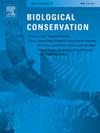Satellite-based remote sensing can enable cost-effective conservation of Eastern North Pacific blue whales: A value of information analysis
IF 4.9
1区 环境科学与生态学
Q1 BIODIVERSITY CONSERVATION
引用次数: 0
Abstract
We estimate the economic value of satellite-based remote sensing for prospective regulation of marine shipping to conserve Eastern North Pacific blue whales in the Exclusive Economic Zone of the United States. Outcomes are driven by application of two data products that can be used to inform the location and timing of vessel speed reductions to limit ship strikes. In the reference case, vessel speed limits are determined using species distribution data from shipboard surveys. In the counterfactual case, speed limits are determined using species distributions predicted by WhaleWatch, a data product incorporating information from several remote sensing technologies. We define the economic value of the remotely sensed information as the cost savings to vessel operators when ocean managers choose vessel speed reductions using the remotely sensed information rather than information based on shipboard surveys. We develop a decision model and an economic framework that allows for estimation of these vessel compliance costs under the two information cases. Using this model and framework, we estimate that the potential annual value of WhaleWatch information ranges between $11 and $636 million (in 2023 USD), depending on the conservation goal that ocean managers seek to achieve. The economic value of the remotely sensed information increases as ocean managers seek to conserve more blue whales and avert more ship strikes.

基于卫星的遥感可以使北太平洋东部蓝鲸的保护具有成本效益:信息分析的价值
我们估计了卫星遥感在美国专属经济区保护东北太平洋蓝鲸的未来海运监管中的经济价值。结果是由两种数据产品的应用驱动的,这两种数据产品可用于通知船舶减速的位置和时间,以限制船舶撞击。在参考情况下,船舶速度限制是根据船上调查的物种分布数据确定的。在反事实的情况下,速度限制是根据鲸鱼观察预测的物种分布来确定的,鲸鱼观察是一种结合了几种遥感技术信息的数据产品。我们将遥感信息的经济价值定义为当海洋管理者选择使用遥感信息而不是基于船上调查的信息来降低船舶速度时,船舶操作员节省的成本。我们开发了一个决策模型和经济框架,允许在两种信息情况下估计这些船舶合规成本。使用这个模型和框架,我们估计鲸鱼观察信息的潜在年价值在1100万美元到6.36亿美元之间(2023年美元),这取决于海洋管理者寻求实现的保护目标。随着海洋管理者试图保护更多的蓝鲸,避免更多的船只罢工,遥感信息的经济价值也在增加。
本文章由计算机程序翻译,如有差异,请以英文原文为准。
求助全文
约1分钟内获得全文
求助全文
来源期刊

Biological Conservation
环境科学-环境科学
CiteScore
10.20
自引率
3.40%
发文量
295
审稿时长
61 days
期刊介绍:
Biological Conservation is an international leading journal in the discipline of conservation biology. The journal publishes articles spanning a diverse range of fields that contribute to the biological, sociological, and economic dimensions of conservation and natural resource management. The primary aim of Biological Conservation is the publication of high-quality papers that advance the science and practice of conservation, or which demonstrate the application of conservation principles for natural resource management and policy. Therefore it will be of interest to a broad international readership.
 求助内容:
求助内容: 应助结果提醒方式:
应助结果提醒方式:


